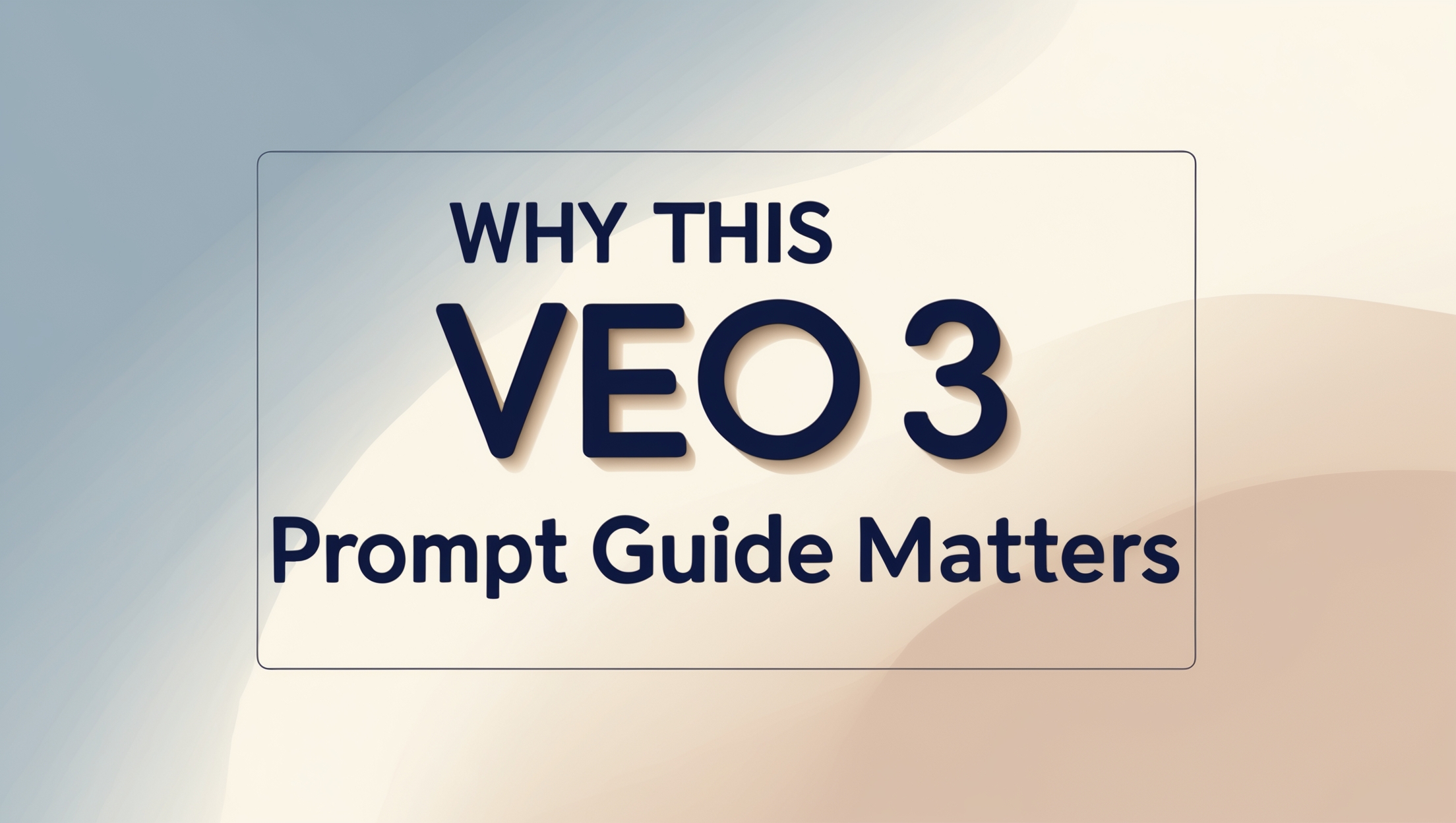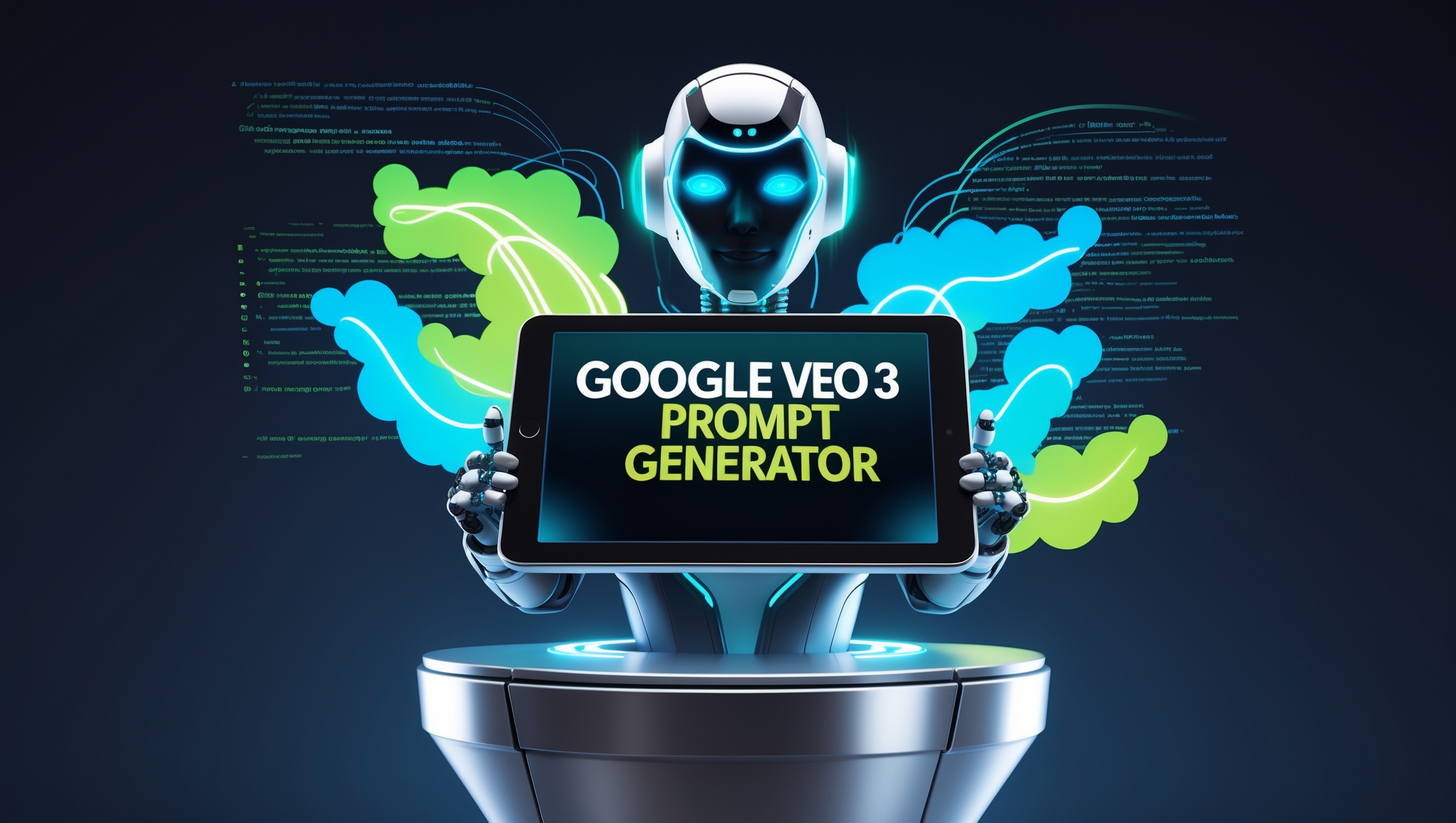Create stunning AI videos with the Veo 3 Prompt Guide – your ultimate handbook for writing powerful prompts that boost video quality and creativity.
Why This Veo 3 Prompt Guide Matters

AI video generation has reached an entirely new level with Veo 3 by Google. Whether you’re a digital creator, a brand strategist, or just someone who loves bringing ideas to life visually, mastering prompts in Veo 3 will make all the difference.
But here’s the catch: writing a great prompt isn’t as easy as it looks. That’s where this comprehensive veo 3 prompt guide comes in. You’ll learn how to structure, refine, and optimize your prompts to get cinematic-quality results.
By the end of this guide, you’ll understand:
What Veo 3 is and how it works
Prompt writing strategies that actually deliver results
Prompt templates for different video styles (cinematic, animated, realistic, etc.)
Common mistakes to avoid
Expert tips to maximize your prompt effectiveness
What is Veo 3 and Why Is Prompting So Important?

Veo 3 is Google DeepMind’s most advanced text-to-video AI model, capable of creating 1080p, cinematic-quality videos from text input. It leverages generative models trained on vast datasets of video and language, enabling it to simulate realistic movement, lighting, and camera dynamics.
However, Veo 3 doesn’t just “understand” you automatically—you must speak its language. This language is called prompting.
Your prompt is the instruction that tells the AI what kind of video to generate. The more precise and creative your prompt, the better the result.
Anatomy of a Powerful Veo 3 Prompt
A good prompt for Veo 3 typically includes:
Subject – What or who is in the scene?
Action – What are they doing?
Environment – Where is the scene happening?
Mood/Tone – What is the atmosphere or emotion?
Camera Instructions – How should it be filmed?
Style Reference (Optional) – Should it mimic a movie, animation, or documentary?
Example:
“A majestic eagle flying over snow-capped mountains at sunrise, cinematic lighting, filmed with a slow-motion drone camera, 4K ultra-realistic.”
Let’s break it down:
Subject: majestic eagle
Action: flying
Environment: snow-capped mountains at sunrise
Mood: majestic, peaceful
Camera Style: drone shot, slow motion
Style: cinematic, 4K
Prompt Writing Tips for Stunning Veo 3 Videos
Here are field-tested prompt strategies that work:
1. Be Visually Descriptive
Use adjectives that evoke imagery. For example:
Instead of “a cat walking,” try “a fluffy white Persian cat gracefully walking across a sunlit wooden floor.”
2. Include Camera and Lighting Details
These make your video look cinematic:
“Aerial drone shot” or “Steadicam following shot”
“Golden hour lighting” or “neon-lit scene at night”
3. Set a Scene
Don’t just list objects; build a setting.
Good: “A bustling Tokyo street at night with neon signs and light rain falling”
Bad: “A city with people”
4. Use Action Verbs
Verbs drive motion.
“A child running joyfully through a sunflower field” is better than “A child in a field”
5. Avoid Vague Words
Generic prompts = generic results. Avoid “beautiful,” “cool,” or “nice.” Instead, use “ethereal,” “gritty,” “sun-drenched,” or “shadowy.”
Veo 3 Prompt Templates for Different Styles
🎬 Cinematic Movie Style
“A lone cowboy rides across a desert plain at golden hour, wide-angle lens, dramatic orchestral background, 4K film style.”
🌆 Urban Realism
“A rainy New York street at night, reflections on the wet pavement, pedestrians with umbrellas, filmed from a taxi window.”
🧙♂️ Fantasy World
“A wizard casting spells inside a glowing crystal cave, magical particles floating, mystical blue light, fantasy RPG atmosphere.”
🐘 Nature Documentary
“An elephant herd crossing a river during sunset in the Serengeti, captured with handheld camera realism, soft ambient soundtrack.”
✨ Surreal/Dreamlike
“A glowing staircase floating in a lavender sky with planets spinning overhead, ambient lighting, ethereal dream world.”
Advanced Prompting Tricks You Should Know
1. Use Time-Based Elements
Mention times of day for different lighting and mood effects:
Sunrise = soft warm lighting
Night = deep shadows, city lights
Dusk = romantic or mysterious tones
2. Reference Famous Styles
You can reference:
“In the style of Wes Anderson”
“Like a National Geographic documentary”
“Inspired by Studio Ghibli animation”
Just ensure the style isn’t copyrighted in context-sensitive environments.
3. Control Perspective
“Over-the-shoulder shot of a knight approaching a dragon”
“POV of a diver exploring a coral reef”
This helps Veo 3 position the camera creatively.
4. Add Motion & Camera Movement
“Tracking shot following a cyclist downhill”
“Zoom-in on a person’s eyes as they cry”
“360-degree pan around a statue in the center of a plaza”
Common Prompting Mistakes to Avoid
Too Short or Generic
Bad: “A nice beach”
Good: “A tropical beach at sunset with waves gently crashing, palm trees swaying in the breeze, cinematic colors”
Contradictory Descriptions
Don’t say “dark sunny sky” or “slow fast motion”Overloading the Prompt
If you cram in too many ideas, the AI gets confused. Keep it focused on one scene at a time.Ignoring Action
Static descriptions don’t utilize Veo 3’s strength in movement.
Veo 3 Prompt Guide for Beginners: Quick Formula
Here’s a simple fill-in-the-blank prompt formula for beginners:
“A [adjective] [subject] [action] in/at [location/environment] during [time of day], [camera style], [lighting description], [emotion or atmosphere]”
Example:
“A cheerful young girl blowing bubbles in a green meadow during golden hour, filmed with a Steadicam, soft sunlight and gentle breeze, joyful atmosphere.”
Using Prompt Variations for Better Output
Veo 3 allows multiple attempts from the same prompt. But small changes can yield dramatically better results:
| Original Prompt | Improved Prompt |
|---|---|
| “A dog playing in snow” | “A golden retriever jumping joyfully through deep snow in a pine forest, bright morning light, close-up slow-motion shot” |
Try changing:
The subject’s description
The environment
Camera angle
Lighting
Action verbs
Final Pro Tips to Get the Most From Veo 3 Prompts
Start simple, then iterate
Run a basic prompt, observe results, refine details.
Use consistent structure
This makes editing and scaling easier.
Document successful prompts
Keep a prompt log or library for reuse.
Mix creativity with clarity
Your prompt is both art and instruction.
Conclusion: Mastering the Art of Veo 3 Prompts
Whether you’re an AI enthusiast or a full-time creative, this veo 3 prompt guide is your go-to resource for crafting visually stunning, story-driven videos using Google’s revolutionary video model.
Prompting is the new directing. The more thoughtfully you write your prompts, the closer you get to creating breathtaking visuals on command.
Start prompting, keep experimenting, and let Veo 3 bring your vision to life.
Frequently Asked Questions (FAQ)
What is Veo 3?
Veo 3 is Google’s latest AI video generation model that creates high-quality videos from text prompts. It supports cinematic effects, camera angles, and realistic rendering based on detailed descriptions.
Why are prompts important in Veo 3?
Prompts are the instructions that tell Veo 3 what kind of video to generate. The clearer and more creative your prompt, the better the visual result.
How long should a Veo 3 prompt be?
An ideal Veo 3 prompt is usually between 20 and 40 words. This provides enough detail without overwhelming the AI.
Can I use Veo 3 in other languages?
Yes, but English currently produces the most accurate and visually pleasing results in Veo 3.
Can I use Veo 3 prompts to make storytelling sequences?
Veo 3 is excellent for short cinematic clips. For storytelling sequences, you may need to generate multiple clips and edit them externally.


